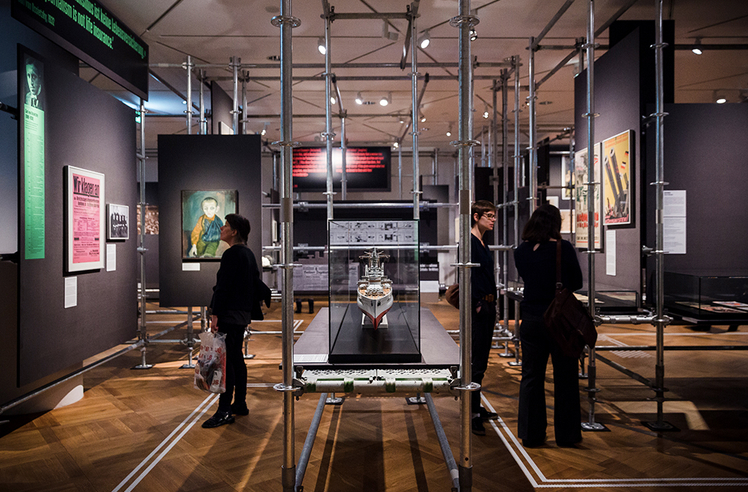What the Weimar Republic Can Teach Us About Modern Democracy
A Berlin exhibition draws on some 250 artifacts to explore questions of democracy past and present
/https://tf-cmsv2-smithsonianmag-media.s3.amazonaws.com/filer/14/b0/14b0f7c4-d05a-426a-8d21-c23b23559799/screen_shot_2019-04-09_at_14410_pm.png)
When you think of the Weimar Republic, you likely envision a turbulent, divisive period in German history that exposed democracy’s vulnerability to authoritarianism and gave rise to Adolf Hitler’s Nazi Party. But through some 250 posters, newspapers, photographs, film and sound recordings, graphic prints, militaria, clothing and everyday objects dating to between 1919 and 1933, a new exhibition at Berlin’s Deutsches Historisches Museum strives to remind visitors that the reality of the regime was far more complex.
“Weimar: The Essence and Value of Democracy,” in the words of an accompanying museum booklet, aims to show how citizens in the republic “dealt with the controversial topic of what democracy is and should be, and how the decisive principles of democracy evolved.”
As a result, curator Simone Erpel explains in an interview with the Associated Press’ Frank Jordans, the exhibition approaches the Weimar Republic from a different perspective than most overviews of the pre-Nazi Germany society. “We didn’t just want to view Weimar from its ending,” she says.
Instead, the exhibition highlights an array of progressive platforms—from women’s suffrage to frank discussions of sexuality, a welfare state that persists to this day and compromise as the fundamental backbone of democracy—raised during the experimental government’s 14-year tenure.
A remodeled Frankfurter Kitchen, for example, reveals the influence of the Bauhaus movement (celebrating its 100 anniversary this year), which lauded streamlined, functional forms that preserved the intangible spark unique to artistic expression. Family planning advertisements and clips from films featuring gay and lesbian love affairs, on the other hand, testify to the openness with which Weimar Germany regarded sexuality.

Despite its emphasis on the oft-overlooked accomplishments of Weimar Germany, the show doesn't ignore the elephant in the room: the fascist state to come. For Deutsche Welle, Nadine Wojcik highlights flags stemming from a debate over the national emblem’s design. As she notes, the Weimar Republic saw a black, red and gold flag replace the black, white and red of the German Empire, but the decision proved controversial until superseded by the Nazis’ introduction of their infamous swastika flag. Among the artifacts on view is a Weimar-era flag kept hidden in a garden shed following the Nazi takeover.
Although Weimar Germany had strict gun regulations, military firearms still managed to make it onto the streets, and some are on display in the new exhibition, foreshadowing the violent political assassinations of the republic’s later years. Photographs of men and women begging for food during periods of hyperinflation further offer a glimpse at what was to come. So, too, does the statement made of clips from the anti-war masterpiece All Quiet on the Western Front featured alongside footage of the widespread right-wing protests that followed the movie’s release. Writing for Smithsonian magazine in 2015, Patrick Sauer explained that its “utter lack of pro-German propaganda and honest, downbeat look at war made the book a Nazi target.” In December 1930, he wrote, “a cadre of 150 Nazi Brownshirts, nearly all too young to have fought in World War I, were led into the theater by propagandist Joseph Goebbels. Spewing anti-Semitic invective at the screen, they repeatedly shouted ‘Judenfilm!’ as they tossed stink bombs from the balcony, threw sneezing powder in the air, and released white mice into the theater.”
Each of the objects on display are intended to dovetail into discussions around democracy that remain relevant today. Rather than shy away from modern parallels, the museum explores those conversations around modern democracy in depth through a parallel “Democracy Lab” exhibition. Spread out across seven themed rooms, the participatory experience encourages visitors to engage with such items as an East German ballot, a jersey worn by soccer star Mesut Özil—who drew heavy criticism last year after being photographed with Turkish President Recep Tayyip Erdoğan—and ties worn by the first same-sex couple to be married in Germany.
The goal is to open up the conversation on the basic foundations of democracy, freedom of expression and the role of mass media. That’s also why the entire “Weimar” display is framed as a makeshift construction site with scaffolding enclosing and supporting the items on view. The implication, heavy handed though it may be, Wojcik writes, is that “democracy is a constant struggle for compromise,” not a way of life that can be taken for granted.
“Weimar: The Essence and Value of Democracy” is on view at the Deutsches Historische Museum in Berlin through September 22.
/https://tf-cmsv2-smithsonianmag-media.s3.amazonaws.com/accounts/headshot/mellon.png)
/https://tf-cmsv2-smithsonianmag-media.s3.amazonaws.com/accounts/headshot/mellon.png)